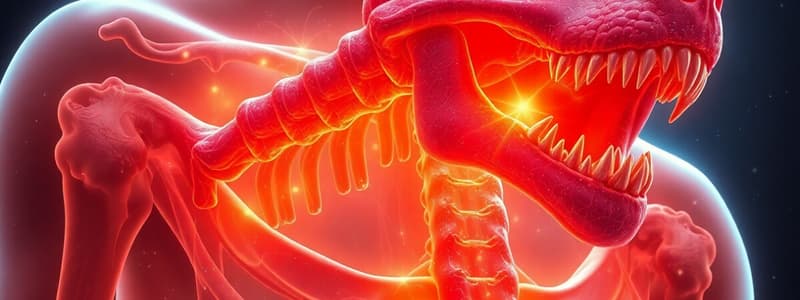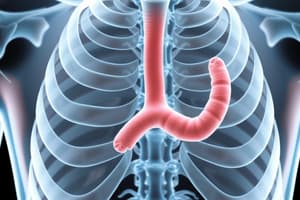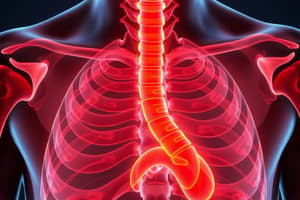Podcast
Questions and Answers
A patient presents with hypocalcemia and is suspected of having hypoparathyroidism. Which laboratory finding, in the absence of renal failure, would strongly support this diagnosis?
A patient presents with hypocalcemia and is suspected of having hypoparathyroidism. Which laboratory finding, in the absence of renal failure, would strongly support this diagnosis?
- Elevated levels of 25-hydroxyvitamin D.
- Elevated levels of intact parathyroid hormone (PTH).
- Decreased serum phosphate levels.
- Increased serum phosphate levels. (correct)
A patient with hypoparathyroidism is being evaluated for potential complications. Which of the following chronic signs or symptoms would be most indicative of long-standing, poorly controlled hypocalcemia?
A patient with hypoparathyroidism is being evaluated for potential complications. Which of the following chronic signs or symptoms would be most indicative of long-standing, poorly controlled hypocalcemia?
- Elevated serum magnesium levels.
- Lenticular posterior cataracts (correct)
- Increased deep tendon reflexes.
- Acute muscle spasms and tetany.
A patient with known hypoparathyroidism presents with increased neuromuscular irritability. What underlying electrolyte abnormality primarily determines the development of these neuromuscular complications?
A patient with known hypoparathyroidism presents with increased neuromuscular irritability. What underlying electrolyte abnormality primarily determines the development of these neuromuscular complications?
- Serum phosphate level.
- Rate of decrease in serum calcium. (correct)
- Absolute serum calcium level.
- Serum magnesium levels.
Which of the following is the most likely underlying cause of hypoparathyroidism in a patient who has undergone a recent total thyroidectomy?
Which of the following is the most likely underlying cause of hypoparathyroidism in a patient who has undergone a recent total thyroidectomy?
A patient with hypocalcemia exhibits resistance to the effects of administered parathyroid hormone (PTH). Which condition should be suspected?
A patient with hypocalcemia exhibits resistance to the effects of administered parathyroid hormone (PTH). Which condition should be suspected?
A patient with hypocalcemia is diagnosed with DiGeorge syndrome. What is the most likely genetic abnormality in patients with DiGeorge syndrome?
A patient with hypocalcemia is diagnosed with DiGeorge syndrome. What is the most likely genetic abnormality in patients with DiGeorge syndrome?
A young child is diagnosed with hypoparathyroidism, chronic mucocutaneous candidiasis, and primary adrenal insufficiency. Which genetic defect is most likely responsible for this patient's condition?
A young child is diagnosed with hypoparathyroidism, chronic mucocutaneous candidiasis, and primary adrenal insufficiency. Which genetic defect is most likely responsible for this patient's condition?
Which of the following laboratory findings would be expected in a patient with pseudohypoparathyroidism Type 1a?
Which of the following laboratory findings would be expected in a patient with pseudohypoparathyroidism Type 1a?
A patient is diagnosed with Pseudopseudohypoparathyroidism (PPHP). Which of the following clinical manifestations is most characteristic of PPHP?
A patient is diagnosed with Pseudopseudohypoparathyroidism (PPHP). Which of the following clinical manifestations is most characteristic of PPHP?
A patient is suspected of having hypoparathyroidism. What should be measured in the patient's laboratory evaluation?
A patient is suspected of having hypoparathyroidism. What should be measured in the patient's laboratory evaluation?
Flashcards
Hypocalcemia
Hypocalcemia
Defined as low serum levels of albumin-corrected total calcium or ionized calcium.
Hypoparathyroidism
Hypoparathyroidism
Hypocalcemia resulting from inadequate parathyroid hormone (PTH) secretion or receptor activation.
Primary hypoparathyroidism
Primary hypoparathyroidism
A state of decreased PTH secretion or inadequate PTH activity.
Parathyroid destruction
Parathyroid destruction
Signup and view all the flashcards
Diagnosis of hypoparathyroidism
Diagnosis of hypoparathyroidism
Signup and view all the flashcards
Chvostek's sign
Chvostek's sign
Signup and view all the flashcards
Trousseau sign
Trousseau sign
Signup and view all the flashcards
Cardiac manifestation
Cardiac manifestation
Signup and view all the flashcards
Treatment of Hypoparathyroidism
Treatment of Hypoparathyroidism
Signup and view all the flashcards
Pseudohypoparathyroidism
Pseudohypoparathyroidism
Signup and view all the flashcards
Study Notes
- Hypoparathyroidism is reviewed
- Dilek Gogas Yavuz from Marmara University Medical School is credited
Terminology
- Hypocalcemia is when there are low serum levels of albumin-corrected total calcium, or low ionized calcium levels
- Hypoparathyroidism is defined as hypocalcemia resulting from inadequate parathyroid hormone (PTH) secretion or receptor activation
Calcium Balance
- Parathyroid hormone (PTH) increases renal tubular calcium absorption
- Parathyroid hormone (PTH) increases intestinal calcium absorption
- Parathyroid hormone (PTH) increases bone calcium mobilization
- Hypocalcemia results from decreased PTH
Hypoparathyroidism
- Primary hypoparathyroidism is a state of decreased PTH secretion or inadequate PTH activity
Etiology
- Parathyroid destruction can cause hypoparathyroidism
- Surgery is a main reason for parathyroid destruction
- Autoimmune issues, cervical irradiation, infiltration by metastasis or systemic diseases can destroy the parathyroid
- Reduced parathyroid function can cause hypoparathyroidism
- Hypomagnesemia, PTH gene defects, or Ca sensing receptor (CaSR) mutations reduce parathyroid function
- Parathyroid agenesis and Familial diseases are causes of hypoparathyroidism
Clinical Symptoms of Hypocalcemia
- Paresthesias involving fingertips, toes, or the perioral area
- Hyperirritability and fatigue
- Anxiety and mood swings or personality disturbances
- Seizures, especially in patients with epilepsy
- Hoarseness due to laryngospasm
- Wheezing and dyspnea due to bronchospasm
- Muscle cramps, diaphoresis, and biliary colic
- Hypomagnesemia, hypokalemia, and alkalosis
Acute and Chronic Signs
- Acute:
- Neuromuscular irritability
- Overt or latent tetany
- Convulsions
- Laryngeal spasm and muscle spasms
- Abdominal pain mimicking surgical abdomen
- ECG changes
- Chronic:
- Diarrhea and dry skin
- Fatigue and dental issues
- Lenticular posterior cataract
- Coagulopathies and cardiomyopathy
Neuromuscular Irritability
- The rate of decrease in serum calcium is the major determinant for the development of neuromuscular complications
- Neuromuscular Irritability presents as:
- Paresthesia, Tetany, and Hyperventilation
- Adrenergic symptoms
- Convulsions are more common in young patients, and can cause generalized tetany, prolonged tonic spasms, and epileptiform seizures
- Signs of latent tetany
- Chvostek’s sign
- Trousseau sign
- Extrapyramidal signs from basal ganglia calcification
Chvostek's Sign
- Existing nerve hyperexcitability seen in hypocalcemia
- Abnormal reaction to stimulation of the facial nerve
- Tapping the facial nerve at the angle of the jaw(masseter muscle) causes facial muscles on the same side to contract due to hyperexcitability of nerves
Trousseau's Sign of Latent Tetany:
- More sensitive than Chvostek's sign for hypocalcemia detection
- Inflating a blood pressure cuff around the arm to greater than systolic BP for 3 minutes occludes blood flow in the brachial artery
- Absence of blood flow, hypocalcemia and subsequent neuromuscular irritability induce spasm of the muscles of the hand and forearm
- The wrist and metacarpophalangeal joints flex. Distal and proximal interphalangeal joints extend, and fingers adduct
- Also know as "hand of the obstetrician"
Muscle Spasms
- Muscle cramps are common in the lower back, legs, and feet
- Laryngospasm and bronchospasm can be life threatening
- Extrapyramidal choreo-athetoid syndromes in patients with basal ganglia calcifications are seen (Fahr syndrome)
- Parkinsonism, dystonia, hemi-ballismus, and oculogyric crises may occur in approximately 5%
- Spastic paraplegia, ataxia, dysphagia, and dysarthria
- Emotional instability, anxiety, depression, confusion, hallucinations, and psychosis occurs when calcium level is low
Cardiac Manifestation
- Prolonged QT interval in the ECG(severe hypocalcemia)
- Resistance to digitalis
- Hypotension
- Refractory congestive heart failure with cardiomegaly
- Long QT interval with normal T waves
- Prolongation of the ST segment with little shift from the baseline
Evaluation
- History:
- Neck surgery
- Family history
- Other autoimmune endocrinopathies
- PE (Chvostek’s sign and Trousseau sign)
- Laboratory:
- Intact PTH, Ca(corrected with albumin)
- Corrected total Ca=measured total calcium + 0.8 x (4.0 − serum albumin)
- P, 25(OH)2D3, Mg
- ECG, Brain MR/CT
Diagnosis of Hypoparathyroidism
- In the absence of renal failure:
- Presence of hypocalcemia with hyperphosphatemia
- Low iPTH
Differential Diagnosis
- Hypocalcemia can be due to other causes
- Pseudohypoparathyroidism
Hypocalcemia Other Causes
- Hypoparathyroidism
- Hypovitaminosis D(COMMON)
- Hypomagnesemia
- Malabsorption
- Renal impairment
- Other reasons
Treatment
- Ca salts like Ca carbonate, Ca citrate, or Ca gluconate
- Active Vitamin D prep like calcitriol
- Recombinant human parathyroid hormone(rhPTH)
- Patients face a lifelong risk of symptomatic tetany, and without access to calcium, may die
- Patients should wear identification for having primary hypoparathyroidism
Asymptomatic Hypocalcemia
- Calcium orally(1000 mg/day)
- Active Vitamin D orally(Calcitriol 0.25–0.5 mcg/day)
- Magnesium(3-4 gr p.o)
- Phosphate restriction in diet with or without aluminum hydroxide gel to lower serum phosphate levels
Emergency Treatment for Hypocalcemia
- Hunger bone syndrome post parathyroidectomy may cause serve hypocalcemia), tetany, laryngeal spasm
- Administer Calcium parenterally until adequate serum calcium level is reached -2 amp Calcium gluconate(10%) which contains 100 elemental calcium/10 mL IV over 10-30 minutes
- Add 6 ampules to 500 mL 5% Dextrose and infuse at 1mg/kg/hr under monitoring
- Follow with:
- Active Vitamin D (Calcitriol 0.25-1 mcg/day)
- Supplementation with oral calcium (1-2 elemental calcium/day)
Complications of Treatment
- Nephrocalcinosis
- Nephrolithiasis
Familial Hypoparathyroidism
- Autosomal dominant: CaSR gene mutation
- The set point for calcium-induced suppression of parathyroid hormone is shifted to the left, causing mildly reduced calcium and parathyroid hormone levels with marked hypercalciuria
- Autosomal recessive:
- PTH gene mutation
- Parathyroid gland agenesis
Pseudohypoparathyroidism
- Lack of G protein and inability of PTH to generate cyclic AMP
- Target organ unresponsiveness to PTH in bone/kidney
- Hypocalcemia
- Hyperphosphatemia
- Elevated PTH
- Ellsworth-Howard test detects a lack of increased cAMP in urine after administration of exogenous PTH
Genetic Defects
- Lack of receptors
- Lack of binding
- Lack of Post receptor effects
- GNAS coding region mutation
- GNAS regulatory region mutation or deletion
- Generalize unresponsiveness
- PHP Type IA, IB
- PHP II
- PPHP (Pseudopseudo Hypoparathyroidism)
Pseudohypoparathyroidism Types
- PHP la
- Has Albright's phenotype
- Serum calcium is decreased
- cAMP response to PTH is decreased
- Response to Phosphorus decreased
- Resistance to All hormones
- Molecular defect has GNAS coding region mut
- PHP lb
- No Albright's phenotype
- Serum calcium is decreased
- cAMP response to PTH is decreased
- Response to Phosphorus decreased
- Resistance to PTH target tissues only
- Molecular defect has GNAS regulatory region mut
- PHP II
- No Albright's phenotype
- Serum calcium is decreased
- cAMP response to PTH is decreased
- Response to Phosphorus has decreased or normal
- Resistance to PTH target tissues only
- Molecular defect is Unknown
- PPHP
- Has Albright's phenotype
- Serum calcium is Normal
- cAMP response to PTH is Normal
- Response to Phosphorus is Normal
- Resistance to None
- Molecular defect has GNAS coding region mut
Albright’s phenotype
- Short stature & limbs
- Obesity
- Round, flat face Short 4e/5e metacarpals
- Archibald sign
- Brachydactyly
- Potter's thumb
- Eye problems
- IQ problems Basal ganglia calcifications
- Type IA: Generalized target organ unresponsiveness and generalized hormone resistance
Pseudo-pseudohypoparathyroidism (PPHP)
- Has Albright phenotype
- GNAS coding region mutation (+)
- Ca and P levels are normal
- Non PTH resistance
- Mimics PHP with AHO phenotype
Idiopathic Hypoparathyroidism
- Autoimmune Polyglandular Syndrome (APS)
- APS Type I:Autoimmune polyendocrinopathy-candidiasis-ectodermal dystrophy (APECED)=Whitaker syndrome
- Candidiasis + hypoparathyroidism + adrenal failure
- PTH / CaSR antibodies
- Age onset 5-9 years , F > M
- APS Type II:Addison disease + thyroid autoimmune diseases + Type 1 DM
- Primary hypogonadism, myasthenia gravis, and celiac disease also are commonly observed in this syndrome. Pathogenesis is poorly understood
- Middle-aged women have shown an increased prevalence of PGA-II
- APS Type III: Failure of the glands to produce their hormones
- APS IIIA - Autoimmune thyroiditis + immune mediated DM (IMD)
- APS IIIB - Autoimmune thyroiditis with pernicious anemia
- APS IIIC - Autoimmune thyroiditis + vitiligo and/or alopecia and/or other organ-specific autoimmune disease
Summary
- Familial syndromes usually cause chronic hypocalcemia without severe symptoms
Studying That Suits You
Use AI to generate personalized quizzes and flashcards to suit your learning preferences.




